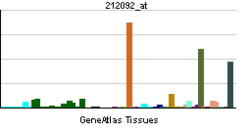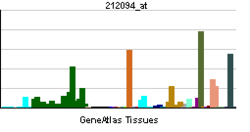- PEG10
-
Paternally expressed 10 Identifiers Symbols PEG10; EDR; HB-1; KIAA1051; MEF3L; Mar2; Mart2; RGAG3 External IDs OMIM: 609810 MGI: 2157785 HomoloGene: 116067 GeneCards: PEG10 Gene Gene Ontology Molecular function • DNA binding
• protein binding
• zinc ion binding
• metal ion bindingCellular component • nucleus
• cytoplasmBiological process • apoptosis
• cell differentiation
• negative regulation of transforming growth factor beta receptor signaling pathwaySources: Amigo / QuickGO RNA expression pattern 

More reference expression data Orthologs Species Human Mouse Entrez 23089 170676 Ensembl ENSG00000242265 ENSMUSG00000092035 UniProt Q86TG7 n/a RefSeq (mRNA) NM_001040152.1 NM_001040611 RefSeq (protein) NP_001035242.1 NP_001035701 Location (UCSC) Chr 7:
94.29 – 94.3 MbChr 6:
4.7 – 4.71 MbPubMed search [1] [2] Retrotransposon-derived protein PEG10 is a protein that in humans is encoded by the PEG10 gene.[1][2][3][4]
This gene includes two overlapping reading frames of the same transcript encoding distinct isoforms. The shorter isoform has a CCHC-type zinc finger motif containing a sequence characteristic of gag proteins of most retroviruses and some retrotransposons, and it functions in part by interacting with members of the TGF-beta receptor family. The longer isoform has the active-site DSG consensus sequence of the protease domain of pol proteins. The longer isoform is the result of -1 translational frameshifting that is also seen in some retroviruses. Expression of these two isoforms only comes from the paternal allele due to imprinting. Increased gene expression (as observed by an increase in mRNA levels) is associated with hepatocellular carcinomas.[4]
Interactions
PEG10 has been shown to interact with SIAH2[5] and SIAH1.[5]
References
- ^ Ono R, Kobayashi S, Wagatsuma H, Aisaka K, Kohda T, Kaneko-Ishino T, Ishino F (Apr 2001). "A retrotransposon-derived gene, PEG10, is a novel imprinted gene located on human chromosome 7q21". Genomics 73 (2): 232–7. doi:10.1006/geno.2001.6494. PMID 11318613.
- ^ Brandt J, Schrauth S, Veith AM, Froschauer A, Haneke T, Schultheis C, Gessler M, Leimeister C, Volff JN (Apr 2005). "Transposable elements as a source of genetic innovation: expression and evolution of a family of retrotransposon-derived neogenes in mammals". Gene 345 (1): 101–11. doi:10.1016/j.gene.2004.11.022. PMID 15716091.
- ^ Brandt J, Veith AM, Volff JN (Aug 2005). "A family of neofunctionalized Ty3/gypsy retrotransposon genes in mammalian genomes". Cytogenet Genome Res 110 (1-4): 307–17. doi:10.1159/000084963. PMID 16093683.
- ^ a b "Entrez Gene: PEG10 paternally expressed 10". http://www.ncbi.nlm.nih.gov/sites/entrez?Db=gene&Cmd=ShowDetailView&TermToSearch=23089.
- ^ a b Okabe, Hiroshi; Satoh Seiji, Furukawa Yoichi, Kato Tatsushi, Hasegawa Suguru, Nakajima Yumi, Yamaoka Yoshio, Nakamura Yusuke (Jun. 2003). "Involvement of PEG10 in human hepatocellular carcinogenesis through interaction with SIAH1". Cancer Res. (United States) 63 (12): 3043–8. ISSN 0008-5472. PMID 12810624.
Further reading
- Andersson B, Wentland MA, Ricafrente JY, et al. (1996). "A "double adaptor" method for improved shotgun library construction.". Anal. Biochem. 236 (1): 107–13. doi:10.1006/abio.1996.0138. PMID 8619474.
- Yu W, Andersson B, Worley KC, et al. (1997). "Large-scale concatenation cDNA sequencing.". Genome Res. 7 (4): 353–8. doi:10.1101/gr.7.4.353. PMC 139146. PMID 9110174. http://www.pubmedcentral.nih.gov/articlerender.fcgi?tool=pmcentrez&artid=139146.
- Kikuno R, Nagase T, Ishikawa K, et al. (1999). "Prediction of the coding sequences of unidentified human genes. XIV. The complete sequences of 100 new cDNA clones from brain which code for large proteins in vitro.". DNA Res. 6 (3): 197–205. doi:10.1093/dnares/6.3.197. PMID 10470851.
- Volff J, Körting C, Schartl M (2001). "Ty3/Gypsy retrotransposon fossils in mammalian genomes: did they evolve into new cellular functions?". Mol. Biol. Evol. 18 (2): 266–70. PMID 11158386.
- Shigemoto K, Brennan J, Walls E, et al. (2001). "Identification and characterisation of a developmentally regulated mammalian gene that utilises -1 programmed ribosomal frameshifting.". Nucleic Acids Res. 29 (19): 4079–88. PMC 60235. PMID 11574691. http://www.pubmedcentral.nih.gov/articlerender.fcgi?tool=pmcentrez&artid=60235.
- Strausberg RL, Feingold EA, Grouse LH, et al. (2003). "Generation and initial analysis of more than 15,000 full-length human and mouse cDNA sequences.". Proc. Natl. Acad. Sci. U.S.A. 99 (26): 16899–903. doi:10.1073/pnas.242603899. PMC 139241. PMID 12477932. http://www.pubmedcentral.nih.gov/articlerender.fcgi?tool=pmcentrez&artid=139241.
- Smallwood A, Papageorghiou A, Nicolaides K, et al. (2004). "Temporal regulation of the expression of syncytin (HERV-W), maternally imprinted PEG10, and SGCE in human placenta.". Biol. Reprod. 69 (1): 286–93. doi:10.1095/biolreprod.102.013078. PMID 12620933.
- Okabe H, Satoh S, Furukawa Y, et al. (2003). "Involvement of PEG10 in human hepatocellular carcinogenesis through interaction with SIAH1.". Cancer Res. 63 (12): 3043–8. PMID 12810624.
- Hillier LW, Fulton RS, Fulton LA, et al. (2003). "The DNA sequence of human chromosome 7.". Nature 424 (6945): 157–64. doi:10.1038/nature01782. PMID 12853948.
- Tsou AP, Chuang YC, Su JY, et al. (2004). "Overexpression of a novel imprinted gene, PEG10, in human hepatocellular carcinoma and in regenerating mouse livers.". J. Biomed. Sci. 10 (6 Pt 1): 625–35. doi:10.1159/000073528. PMID 14576465.
- Suzuki Y, Yamashita R, Shirota M, et al. (2004). "Sequence comparison of human and mouse genes reveals a homologous block structure in the promoter regions.". Genome Res. 14 (9): 1711–8. doi:10.1101/gr.2435604. PMC 515316. PMID 15342556. http://www.pubmedcentral.nih.gov/articlerender.fcgi?tool=pmcentrez&artid=515316.
- Lux A, Beil C, Majety M, et al. (2005). "Human retroviral gag- and gag-pol-like proteins interact with the transforming growth factor-beta receptor activin receptor-like kinase 1.". J. Biol. Chem. 280 (9): 8482–93. doi:10.1074/jbc.M409197200. PMID 15611116.
- Manktelow E, Shigemoto K, Brierley I (2005). "Characterization of the frameshift signal of Edr, a mammalian example of programmed -1 ribosomal frameshifting.". Nucleic Acids Res. 33 (5): 1553–63. doi:10.1093/nar/gki299. PMC 1065257. PMID 15767280. http://www.pubmedcentral.nih.gov/articlerender.fcgi?tool=pmcentrez&artid=1065257.
- He H, Olesnanik K, Nagy R, et al. (2005). "Allelic variation in gene expression in thyroid tissue.". Thyroid 15 (7): 660–7. doi:10.1089/thy.2005.15.660. PMID 16053381.
- Hu C, Xiong J, Zhang L, et al. (2006). "PEG10 activation by co-stimulation of CXCR5 and CCR7 essentially contributes to resistance to apoptosis in CD19+CD34+ B cells from patients with B cell lineage acute and chronic lymphocytic leukemia.". Cell. Mol. Immunol. 1 (4): 280–94. PMID 16225771.
- Kimura K, Wakamatsu A, Suzuki Y, et al. (2006). "Diversification of transcriptional modulation: large-scale identification and characterization of putative alternative promoters of human genes.". Genome Res. 16 (1): 55–65. doi:10.1101/gr.4039406. PMC 1356129. PMID 16344560. http://www.pubmedcentral.nih.gov/articlerender.fcgi?tool=pmcentrez&artid=1356129.
- Li CM, Margolin AA, Salas M, et al. (2006). "PEG10 is a c-MYC target gene in cancer cells.". Cancer Res. 66 (2): 665–72. doi:10.1158/0008-5472.CAN-05-1553. PMID 16423995.
Categories:- Human proteins
- Chromosome 7 gene stubs
Wikimedia Foundation. 2010.
